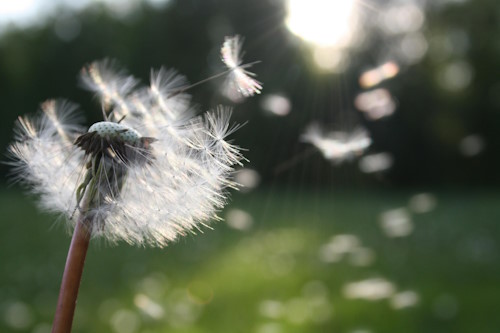The spring allergy season now upon us is going to be a tough one. Learn what you can do to prevent sneezing, itchy eyes, and other symptoms.
With spring just starting, tens of millions of Americans with allergies are bracing for the return of sneezing, congestion, itching, and watery eyes as pollen fills the air.
This year, the spread of pollen is expected to be more intense and longer lasting than in the past, starting earlier in the spring and ending later in the fall.
“Unfortunately, every year pollen counts seem to be getting worse, and that’s largely related to global warming,” says Payel Gupta, MD, an allergist with Tono Health in Brooklyn, New York, and a medical spokesperson for the American Lung Association.
BREAKING: 72-Year Old Grandma's Anti-Aging Discovery Sweeps The Nation
Warmer seasonal air temperatures and more carbon dioxide (CO2) in the atmosphere spur plant growth. This in turn leads to more pollen, a powdery substance created by certain plants as part of their reproduction process.
The Winter Allergy Break Is Getting Shorter
- Tree pollen, generally lasting from February through April
- Grass pollen, from April through early July
- Weed pollen, from August to the first hard frost
“Because spring allergies can start as early as February, and weed pollen allergies can last as late as November, we're really not having much respite from allergies,” says Dr. Gupta.
“Some people can definitely be ‘poly-sensitized’ or allergic to many different environmental allergens, so they may now only get a small break from allergies in the winter, and that break is getting shorter and shorter,” Gupta adds.
Allergy Predictions for 2025
In its allergy forecast for 2025 released last week, Accuweather notes that tree pollen is on the rise in southern U.S. states, but a cold start to the year in the eastern part of the country may keep tree pollen levels low in that region until later in the spring.
“Every region in the country is going to have its own unique, challenging pollen, but there are plants everywhere, and those pollens can travel hundreds of miles, so there’s really no safe place to be when it comes to seasonal allergies,” says Christopher Codispoti, MD, an associate professor of allergy and immunology at UTHealth Houston in Texas.
Worst Cities for People With Allergies
Every year, the Allergy & Asthma Foundation of America (AAFA) lists the U.S. cities that are hardest hit with seasonal allergies. Its top 10 allergy capitals for 2025 are:
- Wichita, Kansas
- New Orleans, Louisiana
- Oklahoma City, Oklahoma
- Tulsa, Oklahoma
- Memphis, Tennessee
- Little Rock, Arkansas
- Raleigh, North Carolina
- Richmond, Virginia
- Greenville, South Carolina
- Greensboro, North Carolina
How to Tell Allergies From a Cold
One of the difficulties with a seasonal allergy is how to tell it apart from a common cold because many of the symptoms overlap. Per Mayo Clinic, both can cause:
- Runny nose
- Congestion
- Fatigue
- Sneezing
“Sneezing will occur with cold and flu, but with allergies you have more of a nasal itch, and the sneezing is often more frequent and intense,” says Dr. Codispoti.
He adds that itchy, puffy eyes are common with allergies but rare with a cold.
Mayo Clinic further notes that allergies rarely cause a sore throat, cough, or fever, while those can be signs of a cold, flu, or other respiratory virus.
Tips to Help Manage Allergy Symptoms
No matter what effects you feel from allergies, many options are available to keep symptoms at bay:
Start your allergy medications as soon as possible. Antihistamines and nasal sprays, whether they’re prescription or over-the-counter, need time to build up in your system, so it’s best to start taking them two to four weeks before allergy season begins.
Discuss medication options with a healthcare provider. Many medication choices are available to treat allergy symptoms, but it can take expertise to find the right match for you. If antihistamines aren’t helping, an allergist may advise trying a nasal spray, for example.
“I find that a big part of my job is making sure that people understand how to use medications appropriately,” says Gupta. “If you’re trying different medications on your own and they’re not working, it might be time to see an allergist.”
Keep windows closed, if possible. Pollen can come through an open window and get into bedding and furniture, worsening symptoms. If you have to open windows at times, an air purifier or air conditioner with a HEPA (high-efficiency particulate air) filter can reduce airborne allergens.
Consider wearing a mask outdoors. If the pollen count is very high, a mask can help block allergens. Gupta says masking can be especially helpful when mowing the lawn or doing other yard work.
Take off shoes and wash clothes. Pollen can enter a home on shoes and clothes. After being outside, leave shoes at the door, and change and wash garments after outdoor activities.
Be cautious with pet contact. Dogs and cats that spend time outdoors can get pollen on their fur, so close contact may worsen symptoms. Bathe your pet regularly and wipe them off when they come inside to limit pollen exposure. Also, keep pets out of the bedroom.
Take a shower at night and wash your face. Before going to sleep, shower to remove pollen from your body so you’re not tracking it to your bed where you could be inhaling it all night. “Pollen can sit on your eyebrows, eyelashes, and in the nose, so rinsing off your face is super important,” says Gupta.
TRENDING: Boost Your Memory With This Easy Trick
Consider a nasal rinse. Rinsing nasal passageways with a saline solution can flush out allergens and relieve sneezing, runny nose, and congestion.
Check pollen counts. Organizations such as the American Academy of Allergy, Asthma & Immunology’s National Allergy Bureau provide allergen reports detailing types of pollen and counts for different parts of the country. Pollen reports can help you plan what precautions you need to take.
Stay inside during the mornings and when windy. Pollen counts are usually worse at these times, so it’s best to limit outdoor activities. Pollen counts are usually better after a rain storm.









